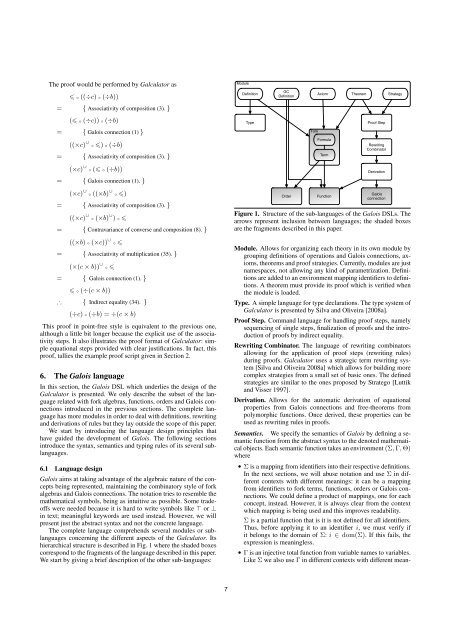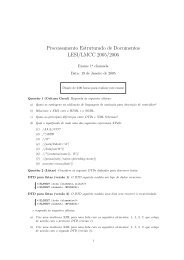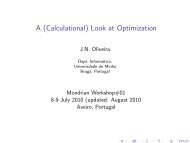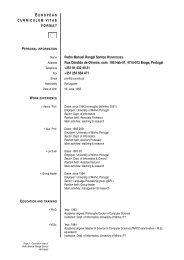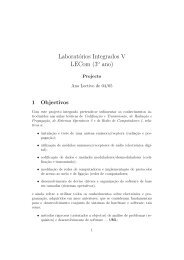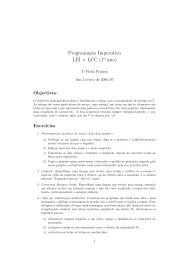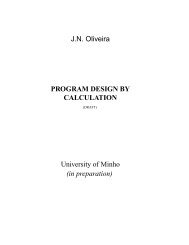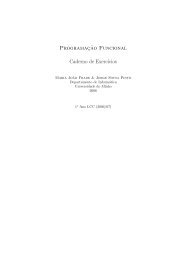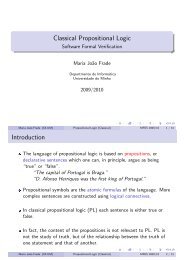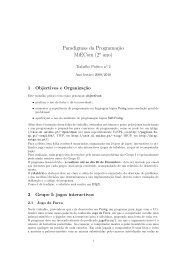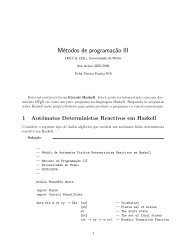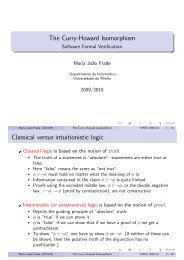Galois
Galois
Galois
Create successful ePaper yourself
Turn your PDF publications into a flip-book with our unique Google optimized e-Paper software.
The proof would be performed by Galculator as<br />
◦ ((÷c) ◦ (÷b))<br />
= { Associativity of composition (3). }<br />
( ◦ (÷c)) ◦ (÷b)<br />
= { <strong>Galois</strong> connection (1) }<br />
((×c) ∪ ◦ ) ◦ (÷b)<br />
= { Associativity of composition (3). }<br />
(×c) ∪ ◦ ( ◦ (÷b))<br />
= { <strong>Galois</strong> connection (1). }<br />
(×c) ∪ ◦ ((×b) ∪ ◦ )<br />
= { Associativity of composition (3). }<br />
((×c) ∪ ◦ (×b) ∪ ) ◦ <br />
= { Contravariance of converse and composition (8). }<br />
((×b) ◦ (×c)) ∪ ◦ <br />
= { Associativity of multiplication (35). }<br />
(×(c × b)) ∪ ◦ <br />
= { <strong>Galois</strong> connection (1). }<br />
◦ (÷(c × b))<br />
∴ { Indirect equality (34). }<br />
(÷c) ◦ (÷b) = ÷(c × b)<br />
This proof in point-free style is equivalent to the previous one,<br />
although a little bit longer because the explicit use of the associativity<br />
steps. It also illustrates the proof format of Galculator: simple<br />
equational steps provided with clear justifications. In fact, this<br />
proof, tallies the example proof script given in Section 2.<br />
6. The <strong>Galois</strong> language<br />
In this section, the <strong>Galois</strong> DSL which underlies the design of the<br />
Galculator is presented. We only describe the subset of the language<br />
related with fork algebras, functions, orders and <strong>Galois</strong> connections<br />
introduced in the previous sections. The complete language<br />
has more modules in order to deal with definitions, rewriting<br />
and derivations of rules but they lay outside the scope of this paper.<br />
We start by introducing the language design principles that<br />
have guided the development of <strong>Galois</strong>. The following sections<br />
introduce the syntax, semantics and typing rules of its several sublanguages.<br />
6.1 Language design<br />
<strong>Galois</strong> aims at taking advantage of the algebraic nature of the concepts<br />
being represented, maintaining the combinatory style of fork<br />
algebras and <strong>Galois</strong> connections. The notation tries to resemble the<br />
mathematical symbols, being as intuitive as possible. Some tradeoffs<br />
were needed because it is hard to write symbols like ⊤ or ⊥<br />
in text; meaningful keywords are used instead. However, we will<br />
present just the abstract syntax and not the concrete language.<br />
The complete language comprehends several modules or sublanguages<br />
concerning the different aspects of the Galculator. Its<br />
hierarchical structure is described in Fig. 1 where the shaded boxes<br />
correspond to the fragments of the language described in this paper.<br />
We start by giving a brief description of the other sub-languages:<br />
Module<br />
GC<br />
Definition Axiom Theorem<br />
Strategy<br />
Definition<br />
Type<br />
Order<br />
Fork<br />
Formula<br />
Term<br />
Function<br />
Proof Step<br />
Rewriting<br />
Combinator<br />
Derivation<br />
<strong>Galois</strong><br />
connection<br />
Figure 1. Structure of the sub-languages of the <strong>Galois</strong> DSLs. The<br />
arrows represent inclusion between languages; the shaded boxes<br />
are the fragments described in this paper.<br />
Module. Allows for organizing each theory in its own module by<br />
grouping definitions of operations and <strong>Galois</strong> connections, axioms,<br />
theorems and proof strategies. Currently, modules are just<br />
namespaces, not allowing any kind of parametrization. Definitions<br />
are added to an environment mapping identifiers to definitions.<br />
A theorem must provide its proof which is verified when<br />
the module is loaded.<br />
Type. A simple language for type declarations. The type system of<br />
Galculator is presented by Silva and Oliveira [2008a].<br />
Proof Step. Command language for handling proof steps, namely<br />
sequencing of single steps, finalization of proofs and the introduction<br />
of proofs by indirect equality.<br />
Rewriting Combinator. The language of rewriting combinators<br />
allowing for the application of proof steps (rewriting rules)<br />
during proofs. Galculator uses a strategic term rewriting system<br />
[Silva and Oliveira 2008a] which allows for building more<br />
complex strategies from a small set of basic ones. The defined<br />
strategies are similar to the ones proposed by Stratego [Luttik<br />
and Visser 1997].<br />
Derivation. Allows for the automatic derivation of equational<br />
properties from <strong>Galois</strong> connections and free-theorems from<br />
polymorphic functions. Once derived, these properties can be<br />
used as rewriting rules in proofs.<br />
Semantics. We specify the semantics of <strong>Galois</strong> by defining a semantic<br />
function from the abstract syntax to the denoted mathematical<br />
objects. Each semantic function takes an environment (Σ, Γ, Θ)<br />
where<br />
• Σ is a mapping from identifiers into their respective definitions.<br />
In the next sections, we will abuse notation and use Σ in different<br />
contexts with different meanings: it can be a mapping<br />
from identifiers to fork terms, functions, orders or <strong>Galois</strong> connections.<br />
We could define a product of mappings, one for each<br />
concept, instead. However, it is always clear from the context<br />
which mapping is being used and this improves readability.<br />
Σ is a partial function that is it is not defined for all identifiers.<br />
Thus, before applying it to an identifier i, we must verify if<br />
it belongs to the domain of Σ: i ∈ dom(Σ). If this fails, the<br />
expression is meaningless.<br />
• Γ is an injective total function from variable names to variables.<br />
Like Σ we also use Γ in different contexts with different mean-<br />
7


